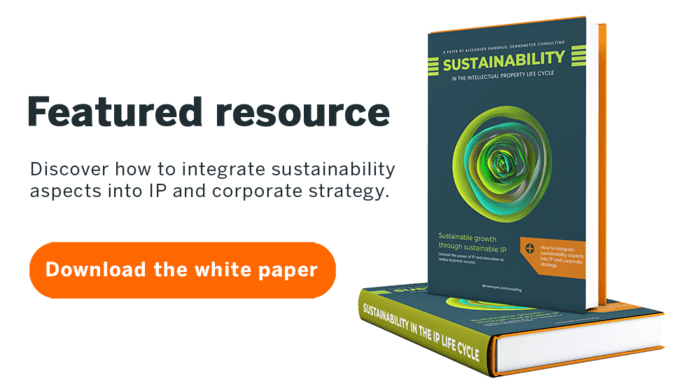
Sustainability in the Intellectual Property life cycle
Businesses worldwide are increasingly expected to prioritize environmentally and socially responsible practices and act "sustainably" as an organization. Scrutiny may come from investors, customers, staff or business partners, and such pressure often demands strongly defined goals combined with clear ways to measure progress.
To cultivate the right perception, it is necessary to demonstrate sustainable operations through reporting, decision-making and marketing. In the EU, for instance, the proposed Corporate Sustainability Reporting Directive (CSRD) would expand reporting requirements for all large companies and those listed on regulated markets. This directive would introduce more detailed disclosure obligations while mandating audits of published information and the digital tagging of data. There are also voluntary initiatives: Last year, a group of more than 70 companies agreed on the Stakeholder Capitalism Metrics, a set of universal disclosures on environmental, social and governance (ESG) issues. In cooperation with the World Economic Forum, these international companies pledged to incorporate the agreed metrics into their published materials (including annual and sustainability reports).

Among the 70 initial signatories were BP, Dell, Heineken, HSBC, IBM, Mitsubishi, Petronas, SAP, Unilever and Wipro. It is worth noting that the companies involved represent a broad range of sectors, from energy generation and heavy industries to financial services, consumer products and entertainment. Many large and small businesses welcome the focus on sustainability, even finding that this new emphasis aligns with programs they were already committed to. However, it can also prompt difficult or uncomfortable decisions regarding pricing, investment, supply chains or even the organization's strategic direction.
Companies can not afford to ignore ESG goals any longer
IP can be a powerful way to demonstrate that a business is delivering on expectations.
Intellectual Property (IP) is vital to the success and furtherance of innovation and creativity, and so it follows that sustainability should also be integrated holistically into IP strategy and management. This means considering ecological and community priorities at all stages of the IP life cycle: R&D for identifying and creating new inventions, procurement of exclusive rights, portfolio management and valuation and, finally, commercialization. While that may sound challenging, there are many touchpoints where sustainability can be integrated into a sound IP strategy. Moreover, as our white paper shows, IP can be a powerful way to demonstrate to stakeholders what a business is achieving in terms of environmental protection and how it is delivering on expectations.
What is sustainability?
Many organizations now concentrate on ESG matters, which can include everything from cutting carbon emissions to embracing equal opportunities and promoting boardroom accountability. Probably the most helpful and comprehensive definition is provided by the United Nations' 17 Sustainable Development Goals (SDGs).
The SDGs are at the center of the 2030 Agenda for Sustainable Development, adopted by all UN member states in 2015. The targets of the Agenda span from ending poverty and reducing inequality to improving health care and education. There is also a focus on economic growth while tackling climate change and preserving our oceans and forests. Sustainability, therefore, incorporates both environmental aspects (such as reducing excess packaging, switching to cleaner fuels and recycling) and broader awareness that includes responsible use of resources, efficient operations and providing long-term value to society. This second facet involves approaching business conscientiousness from various perspectives: human, financial and social.
Regarding the first component, we increasingly see companies promoting green products and services: automakers switching to electric vehicles, energy companies investing in renewable sources and retailers providing reusable bags and other containers. Much of this shift relies on new technologies or improvements to existing processes to make them more efficient and less wasteful. This is where IP comes into play, incentivizing these innovations and getting them to the market. For example, IP practitioners can drive this change by carrying out portfolio assessments that identify ecological benefits in existing technologies, harvesting suitable inventions and mapping their IP assets against green metrics.
Sustainability should be integrated into a good IP strategy
In almost every part of the IP life cycle, sustainability aspects can generate added value.
The second element is more complex, but again IP has a significant role. Consistent value can be generated by licensing IP rights for technology transfers. This can include delivering innovation to new geographical markets or customer segments. Creative licensing can also ensure that discoveries are fully exploited by accommodating new applications for existing inventions, whether it is a repurposed drug, a manufacturing technology integrated into a consumer product or a software program adapted to a new function.
Investment in innovation and IP protection can provide far-reaching advantages to staff, customers and investors, creating a financially solvent and socially supportive business that is adapted for success and contributes positively to society.
Discover how to create and maintain a sustainable IP portfolio and the areas where IP can contribute to a company's overall sustainability goals by downloading our white paper.
Filed in

What are the three pillars of IP innovation, and how can C-suite members maximize the value of assets that are, by definition, less than concrete?



